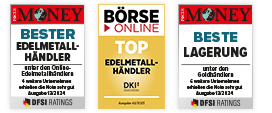Direct investments in silver or gold mining shares
Not only are precious metal prices quoted on the stock exchange, but the shares of listed, precious metal mining companies are also traded, and new shares in these companies are issued for the purpose of equity financing of investments and the efficient build-up of capital stock (the alternative would be debt financing of investments by financial intermediaries such as banks, but they do not grant loans on the basis of criteria determined on markets). Even though mining companies are characterized by a number of special features, investments in listed mining companies are ultimately the purchase of shares. Their prices can therefore fluctuate, usually even more than the shares of listed companies in other sectors. Since the (uncertain) future is traded on the stock exchange, the valuations of precious metals companies - as well as precious metals prices - thus have the market's future expectations priced into them.
Due to psychologically inspired phenomena, there are sometimes strong exaggerations of the prices - as well as the prices for precious metals - upwards (euphoria) or downwards (panic). Financial market instruments such as derivatives or short selling amplify these price fluctuations. In the long term, however, prices are determined by fundamental data, in particular the level and development of corporate profits and the expected relationship to the return on other forms of investment such as bonds or real estate. If there is a strong discrepancy between speculatively inflated prices and fundamentally appropriate valuations, this is referred to as a speculative bubble, which is difficult to diagnose in advance, but which will burst sooner or later. The purchase of shares in precious metal producing mines is therefore associated with opportunities and risks. Fraud cannot be ruled out in the mining industry either.
The supposedly biggest gold find of all time[1]
The story surrounding the gold mining company Bre-X is considered one of the biggest scandals in mining history and made headlines around the world. The Busang gold deposit in Borneo, owned by the Canadian exploration company Bre-X, was considered one of the largest gold deposits in the world in the mid-1990s. Initial resource estimates in 1992 were 7 million ounces of gold. Bre-X shares were trading at less than half a Canadian dollar at the time. Gold giants such as Barrick Gold, Newmont Mining and Placer Dome were already beginning to take an interest in Busang. A new resource estimate in 1995 was 16 mill. ounces of gold, internal company estimates even assumed a potential of up to 200 mill. ounces (for comparison: global gold mine production was 90 mill. ounces in 2011). Comparisons have already been made with the Witwatersrand Basin in South Africa or the Carlin Trend in Nevada. The stock price rose to over 200 Canadian dollars in 1996, and the market capitalization to about 6 billion Canadian dollars. Serious consideration was given to including Bre-X in the Dow Jones Index. By the end of 1996, the stock was listed on NASDAQ.
In early 1997, the tide turned: rumors surfaced that all was not well with the rock samples. The share price then plummeted dramatically. Audits eventually revealed that the rock samples used to calculate stock levels had been massively manipulated from the start. The chief geologist of Bre-X, Michael de Guzman, then allegedly committed suicide by throwing himself out of a helicopter from a height of 250 meters above the jungle. The body, found after days of searching, was barely identifiable, but was declared to be Guzman's after several autopsies. In addition, a fire destroyed most of the geologist's papers. Were these all coincidences? Hardly, because later it came out that the helicopter crash was probably faked, while Guzman in fact went into hiding in Brazil. In this way, he evaded responsibility until today.
Guide to precious metals in the operating assets free of charge as eBook
This guidebook is aimed at entrepreneurs who are considering shifting liquidity reserves or reserves into gold and silver or other precious metals in order to circumvent negative interest rates, hope for increases in value or want to minimize bank and currency default risks. You will receive the guide free of charge as a PDF file when you sign up for our newsletter.
Valuation of mining companies
For an adequate assessment of mining companies, which creates the basis for identifying possible over- or undervaluations, the following criteria should be used:
1.Stage of development of the company: explorers are valued lower by the stock market than junior or senior producers that are already generating positive cash flow - sales less extraction costs, amortization and taxes. This is due to the fact that the feasibility of exploration projects still has to be tested by feasibility studies and then implemented. These companies usually do not yet generate sales, but only costs, and the success of the projects is uncertain. If feasibility studies are available, it should be noted which assumptions have been made regarding investment amounts, financing and production costs, planned production volumes and assumed precious metal prices. In addition to explorers and producers, there are also precious metal companies that neither explore nor produce, but primarily sell precious metals on the basis of license agreements.
2.Company size: Mining companies with only a few mining projects run the risk of drastic price reductions if problems arise. While small, largely undiscovered exploration companies can experience spectacular share price increases if they prove successful with their projects, it is very difficult to locate them. Therefore, one should rather invest in companies whose prospects of success are foreseeable.
3.Geographical location: Care should be taken to ensure that the countries in which the company operates are stable and legally reliable. Otherwise, there is a risk that mining concessions will not be honored as agreed or that mines will be nationalized. Also important is the infrastructure (energy supply, transport links), which is sometimes inadequate in remote areas.
4.Management: The quality of management is very crucial to the company's success. Managers should be experienced individuals who have already proven that they can lead a mining company to success. In this regard, management should include proven geologists as well as individuals with strong financial and business skills.
5. Financial data: Also of key importance is the amount of debt the company has, the level of cash and cash equivalents, and how easy it is to obtain these when needed, as this will determine, among other things, the extent to which financial lean periods can be overcome or new projects financed. The possibilities for carrying out capital measures depend, among other things, on the level and development of stock market prices. This and the expected future cash flow are decisive in determining the extent to which the anticipated financing costs of the mining projects can be borne. The development of costs must also be kept in mind, i.e., the anticipated level of future fixed costs and cash costs (variable production costs) per ounce. Furthermore, the extent to which a mining company plans to hedge against fluctuations in precious metal prices by hedging via the futures markets is of importance. Finally, important valuation ratios in securities analysis are the price-sales ratio and the price-earnings ratio.
6.Resource basis: Exploration companies do not yet have any sales, so ratios such as the price-turnover or price-earnings ratios cannot be used as valuation yardsticks. The market capitalization and net asset value of a mining company in relation to the resources determined according to international standards, which have been proven by drilling results or can be derived from them, are therefore important valuation criteria for mining companies. Market capitalization is the stock market value of a company (shares in circulation multiplied by the share price), while the net asset value of a mining company - which is also referred to as net asset value - is derived from the expected future cash flow and net working capital less long-term liabilities. Comparing the market capitalization or net asset value per ounce of underground reserves or resources with similarly oriented companies(peer group comparison) allows an assessment of the extent to which a company's valuation is appropriate. The resources of a mining company often include several metals, which therefore have to be converted for aggregation (e.g. divided into silver price ). Also of interest is the extent to which a company plans to expand its resource base through drilling programs or acquisitions and how realistic their realization is.
Precious metal companies are subject to strong price fluctuations
Listed precious metal companies have been subject to strong price fluctuations in recent years. After a previous significant rise in the share prices of mining companies, these fell into a bottomless pit until the height of the financial market crisis in November 2008. Even if there were rational reasons for the price drops - e.g. the decline in precious metal prices or the deterioration in financing conditions for mining projects - their extent was also due to market psychological factors and irrational exaggerations.[3] A stock market adage says: Buy when the guns are thundering. November 2008 was probably such a time: After the powder had settled, the selling panic subsided, fundamental considerations moved back into focus and the prices of mining companies recovered significantly. With dizzyingly high precious metal prices and stock market prices of the precious metal mines, in a few years the BILD newspaper, as a reliable contra-indicator, will then blow full of fervor to get in. At the peak of the upswing of the precious metal prices it will come then namely again to irrational exaggerations, this time upward. That would then be the right time to exit, because according to another stock market adage, a price rise begins in panic and ends in euphoria.
Leverage effect with mining shares
When precious metal prices rise, there is often a disproportionate increase in the prices of mining shares, which can be attributed to a leverage effect: since the extraction of precious metals incurs costs, earnings rise disproportionately when precious metal prices rise. For example, if the price of silver rises from US$20 to US$50, i.e. by 150%, and mining costs are US$10 per troy ounce, then earnings per ounce rise from US$10 (20-10) to US$40 (50-10), i.e. by 300%. The increase in the price of silver thus acts like a lever on the company's earnings. Incidentally, the higher the costs, the higher the leverage. It increases further if a company finances itself partly with borrowed capital, since the return on equity then increases even faster than that of a debt-free company, at least if the cost of borrowed capital is lower than the return on total capital.
So should one invest primarily in highly indebted companies with the highest possible extraction costs? Provided that precious metal prices rise and the return on total capital achieved exceeds the interest on debt, this is indeed to be answered in the affirmative, provided that the other factors - quality of management, etc. - are roughly equal(ceteris paribus conditions). In any case, high production costs and debt do not fundamentally argue against an investment in a mining company. However, it should not be ignored that, according to an old adage, the stock market is not a one-way street, because prices can ultimately also fall. The leverage effect then works in the opposite direction. In addition, if precious metal prices remain low, the existence of a company with a higher level of debt may be at risk.
There is another specific feature of mining companies that needs to be taken into account: Mining production is limited in time, as production can only take place until the resources are exhausted. With every ounce of silver mined, a yield is generated, but at the same time the resource stock is reduced by one ounce. Assuming that the life of a mine is ten years, the profit that can be realized during this time must be discounted to today's present value, which, under the simplifying assumption that all machinery and other company assets would then also be depreciated, would correspond to the present value of the company.
When investing in a mining company, the amount of hedging stock should also be considered. After the turn of the millennium, many mining companies had problems with their high hedging stocks. The background for their build-up was that the companies had sold parts of their future production in advance via the futures markets in order to create planning security on the one hand and to finance the costs of mine operation on the other. As precious metal prices rose again after a long lean period, they were initially unable to participate in this. Accordingly, their stock prices also lagged behind the development of precious metal prices. In anticipation of further price increases, they then engaged in targeted de-hedging.
Book & eBook "Gold & Silver for beginners" free for you
"An exciting and educational book that will spark interest in investing in precious metals even for people like me who have never looked into this topic before." - Concluded the editor, who subsequently bought gold for the first time.
What are the pros and cons of precious metals? Which bars and coins are recommended and why? What are typical beginner mistakes and how can you recognize a reputable precious metals dealer? Where and how to store precious metals safely? To these and many other questions (not only) beginners will find answers and tips in this approximately 200 pages comprehensive basic reading of precious metals expert Tim Schieferstein on the subject of gold and silver.
With this book we would like to carry out clearing-up work and make so the entrance into a capital investment in precious metals easy. Therefore GoldSilberShop.de gives both the eBook and the printed book to you! Secure your copy today!

Weitere Informationen und Ihre nächsten Schritte:
Geschichte von Edelmetallen als Währung
Angebot, Nachfrage und Bestände
Historische Wertentwicklung
Prognose für die zukünftige Wertentwicklung
Investitionsmöglichkeiten
Zusammenfassung
Silber Neuheiten
Feinsilber
Silber kaufen
1 kg Silbermünzen
1 Unze Silbermünzen
Silberunze
Tubesize
Silberankauf
Ankauf von Silberbarren
Ankauf von Silbermünzen
Maße & Gewicht: Silberbarren
Mehrwertsteuer bei Silber
Silberpreis
Das deutsche Stempelgesetz von 1884
Edelmetalle
Edelmetalle kaufen
Edelmetalle verkaufen
Gold, Silber lagern
Gold-Silber-Ratio
Privy Mark Münzen
Goldsparplan oder Silbersparplan
Goldverbot
Echtheit von Gold prüfen
Hausratversicherung für Gold
Tresor
Bankschließfach







